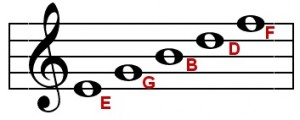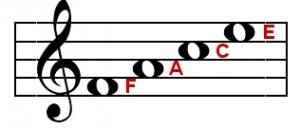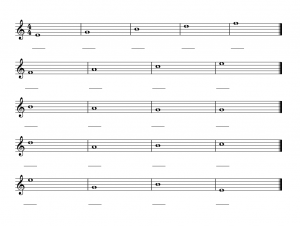Designed for the artistic stingray
The Five-line Staff
The Five-line Staff
The five-line staff is where we write/read the actual notes we’re going to play. We use the musical alphabet – A B C D E F G A B C D E F G. On the staff, each line is one note and each space is one note. What note do you think this example is?

It’s a trick question, because that isn’t really a note. We have to add something called a clef to the start of the staff in order for the lines and spaces to represent a note. One of the most commonly used clefs is Treble Clef. Let’s put a clef on the staff and try to name that same note again.

Now that we have a Treble Clef on there, the middle line is a B. If you remember the order of the alphabet you can figure out every other note on the staff.
For example what letter comes after B in the alphabet?

C! So the space above the middle line would be the note C.
What note comes before B in the alphabet?

A! So the space below the middle line would be the note A.
(Remember A and G are next to each other in the musical alphabet)

Being able to read the five-line staff really comes down to experience and memorization. There are a couple of tricks you can use to memorize the lines and spaces…

Using those letters we can make a little saying:
Every Good Boy Does Fine
Here are a couple of other silly examples:
Every Guy’s Bird Deserves Feathers
Even Giraffes Bite Dirty Flamingos
Elmo’s Great Big Dinosaur Flies
Every Good Baby Deserves Fanta

I like to use a little rhyme to help memorize the spaces: All the notes in a space, F A C E face!
The more you practice reading these lines and spaces, the better you get at it and the faster you can read music. Here is a practice sheet you can print and fill out:








